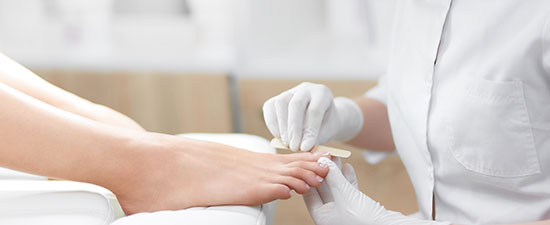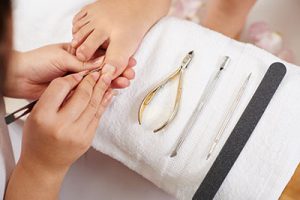Want a pedicure? There’re so many salons, how do you choose the right one… or a safe one?
If you are using Yelp or other consumer review sites to determine where to go, the selection can be overwhelming. Just in the Los Angeles area alone, there are over 6,000 salons listed!
As podiatrists, we see the aftermath of when pedicures go wrong, and they south more that every once in a while. So the next time you get a pedicure, here’s some things to keep in mind so that you can relax and enjoy the experience… and avoid seeing me!
Start by only choosing a licensed nail salon
The California Board of Barbering and Cosmetology, the governing agency that regulates manicuring services, states you must have a license as a cosmetologist or manicurist to trim nails in a salon. Additionally, the salon must have a license from the state to provide these services.
These licenses must be on display1.
To clean, or not to clean, that is the question.
When going to a salon, we consumers tend to assume the tools used on us are clean. There are specific regulations regarding the different tools that can’t cleaned and reused versus tools that can only be used once.
In nail salons, any tool that cannot be disinfected must be thrown out after one use. This would include products like emery boards or toe spacers2.
- Nail nippers or other metal tools utilized on clients have a protocol for disinfection. It is important they are cleaned with an EPA registered disinfectant used against bacterial, fungal and viral infections.
- No tool should ever be used on one client without be disinfecting prior to using again. If not, you’ll be exposed to fungal infections as well HIV or hepatitis2,5.
A study by Gupta et al found toenails are more likely to develop onychomycosis, or fungus in the nail, as compared to fingernails6. Therefore, it is important to try to use techniques that will avoid the exposure to fungal organisms.
Water, water, what the heck is in the water?
There is no denying how relaxing it can be when you submerge your feet in the warm water as you start your pedicure. The original spa pedicure chair was invented in 1985 by John Meyerovich 2,3.
Prior to this invention, nail technicians would fill a basin with warm water then exchange the water when it cooled with warm water. The early design utilized a pipe system to create the whirlpool effect. The challenge with the design of this chair was effectively cleaning the piping system after each use.
Newer chairs utilize a pileless system involving air jets to move the water. The benefit of this new design is ease of cleaning4. It is important to have a clean basin in order to prevent the spread of fungus or other infectious agents as well as to not have any residual contaminants from another client’s feet.
Just as there are disinfection protocols for tools, so do the basins. After each use the basin must be cleaned as well as at the end of the day and on a weekly manner6.
What’s up with your cuticles?
During a pedicure, the technician typically removed the cuticle. The cuticle or eponychium, is a protective barrier at the junction of your skin and the nail. When you have your cuticle removed, you are exposing this area to infection
Should you cut your nails straight or rounded?
As a podiatrist, we recommend cutting nails straight across. When the corners are cut, there are times when the entire nail border is not fully removed, and the far edge of nail is left behind, it creates a spike of nail. As the nail grows, it can dig into the nearby skin.
This spicula of nail irritates the skin leading to pain and infection. Additionally, in attempts to trim the nail out, you might get a small cut which in turn could also lead to an infection.
When should you stop pretending your toes will heal thyself and see your Podiatrist?
If you start to notice your toe becomes red, hot, swollen, painful, or drainage, you should contact a podiatrist to schedule an appointment.
Treatment will depend on the severity of the infection and where along the nail the spicule is located. If infected ingrown nails are left untreated, the infection can spread to the nearby bone.
Pedicures are relaxing experiences. But if you notice something that does not seem quite right, do not be afraid to speak up.
Should you unfortunately develop a complication after the pedicure, we are here to help! All the doctors here at UFAI are thoroughly trained and highly skilled in the care and feeding of your foot and ankle. 🙂
Our nationally recognized foot and ankle specialists offer the most advanced podiatric care with the highest success rates in the nation. We are leaders in the research and treatment of all foot and ankle conditions.
For more information or to schedule a consultation, please call (877) 736-6001 or visit us at www.footankleinstitute.com.
- Board of Barbering & Cosmetology. “Manicure & Nail Salon Services Fact Sheet.” California Department of Consumer Affairs Board of Barbering & Cosmetology, Aug. 2004, cchealth.org/warnings/pdf/manicure_factsheet.pdf.
- US Pedicure Spa. “History Of A Pedicure Chair.” US Pedicure Spa, 26 Jan. 2014.
- Leszczewicz, Heather. “Pedicure Spa Chair Gets Start in Wisconsin.” OnMilwaukee.com, 13 Apr. 2006, 05:10, onmilwaukee.com/market/articles/europeantouch.html.
- Aria Chairs. “What Are Pipeless Pedicure Chairs?” Aria Chairs, 2021.
- “California State Board of Barbering and Cosmetology Act and Regulations .” Department of Consumer Affairs Board of Barbering and Cosmetology, 2018, www.barbercosmo.ca.gov/.
- Gupta AK, Jain HC, Lynde CW, Macdonald P, Cooper EA, Summerbell RC. Prevalence and epidemiology of onychomycosis in patients visiting physicians’ offices: a multicenter Canadian survey of 15,000 patients. J AM Acad Dermatol. 2000. Aug; 43(2pt1):244-8.
- What To Do When Your Toenail Is Falling Off - October 21, 2024
- How To Tell If You Have Wide Feet - October 3, 2024
- 15 Summer Foot Care Tips to Put Your Best Feet Forward - July 1, 2024

 In nail salons, any tool that cannot be disinfected must be thrown out after one use. This would include products like emery boards or toe spacers2.
In nail salons, any tool that cannot be disinfected must be thrown out after one use. This would include products like emery boards or toe spacers2.
Leave a Reply